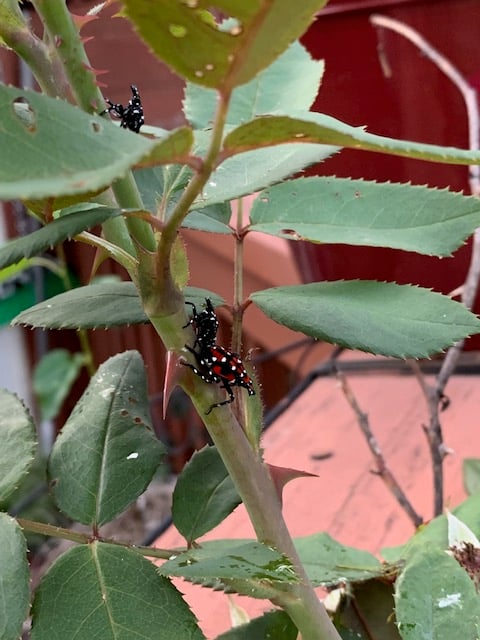One of the worst agricultural pests in recent history has hit New Jersey and Pennsylvania again this year. Spotted lanternflies have been making the headlines due to their destructive nature with no known way to eradicate them. Pest control companies are unable to help as crops and vegetation suffer from irreversible damage that is crippling local farmers in their wake. As of September, we are currently in the “adult” and “egg laying” stages of their life cycle so you’ll see them flying and jumping around and leaving behind grey smudges that are actually their egg masses. The adult spotted lanternfly pictured below was found by a Cooper Pest Technician in New Jersey on September 17th, 2019.

What do spotted lanternflies look like?

Photo Credit: Penn State University
Spotted lanternflies look different during each of the stages in their lifecycle. Eggs are found in “masses” of 30-50 eggs that appear to be what some describe as splotches of mud or unevenly spread mortar. If you see a suspected egg mass, scrape it off into a bag or container and either submerge it in alcohol or hand sanitizer to kill them. Never leave spotted lanternfly egg masses alone. The easiest way to control them is to kill them before they hatch.

Photo Credit: U.S. Department of Agriculture
Once spotted lanternflies hatch from their eggs, they emerge in the nymph stage. They are black or red with white polka dots and roughly between ¼-½ inch long.

They feed on a large host of plants including fruit trees, vegetables, vines, and the tree of heaven. If you have a tree of heaven on your property, there is a significantly greater chance that spotted lanternflies will invade because it’s their primary food of choice.
Tree of Heaven, Ailanthus altissima

Photo by Gary Huntzinger Rutgers NJAES Cooperative Extension
This not so heavenly tree is considered to be a weed, popping up naturally instead of ornamentally planted. Tree of heaven was first found in the Philadelphia area in 1784. Since then, it has spread across the nation as a highly invasive tree, still common to our area today. Problems persist with their growth due to the challenges their removal poses. Your first thought is probably to call a professional to take the tree down completely. Unfortunately, tree of heaven has an elaborate root system underground that makes it near impossible to prevent regrowth after removal. Cutting down a tree of heaven is not recommended because of the potential to grow even more extensively once the roots begin to repair. Guidelines for homeowner efforts in spotted lanternfly control for tree of heaven can be found here as outlined by the Penn State Extension.

Pictured Above: A Cooper Pest Solutions Technician found this spotted lanternfly in September of 2019
In adulthood, spotted lanternflies look much different. They are about 1 inch long with spotted gray wings and spotted red hind wings. They are “plant hoppers,” jumping from tree to tree as their main form of transportation. Although adult spotted lanternflies have wings, they are very weak fliers.
How do spotted lanternflies spread?
Spotted lanternflies spread in several ways. They can hitchhike in cars and open transportation vehicles such as horse trailers and dog crates. By parking under trees, you put yourself at a greater risk of spotted lanternflies entering your car whether it be from a window left cracked open, when a door opens, or in trunks. They are known to rest on the outside of cars which makes it easy for you to unknowingly spread them. Although they do not pose direct health treats to humans and pets in terms of biting or spreading disease, agriculture and vegetation are highly at risk to their breeding and activity.
What to Do If You Find Spotted Lanternflies or Spotted Lanternfly Eggs
Cooper Pest Solutions does not provide elimination or prevention services for spotted lanternflies. If you find spotted lanternfly egg masses, please report it to the property entity based on your state.

